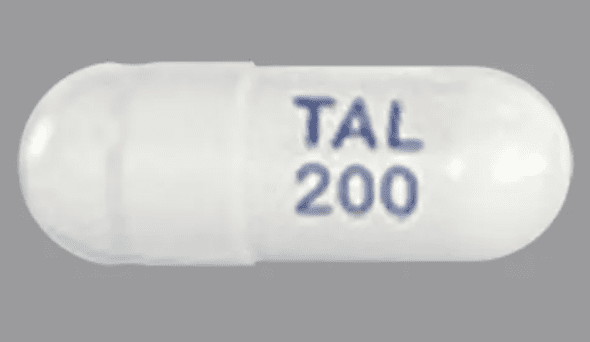Taletrectinib Side Effects
Applies to taletrectinib: oral capsule.
Important warnings
This medicine can cause some serious health issues
Use only as directed.
Tell your doctor if you use other medicines or have other medical conditions or allergies.
Get emergency medical help if you have signs of an allergic reaction: hives, difficult breathing, swelling of your face, lips, tongue, or throat.
Call your doctor at once if you have:
-
sudden pain or trouble moving your hip, wrist, or back;
-
heart problems--swelling, rapid weight gain, feeling short of breath, fast or pounding heartbeats, fluttering in your chest, or sudden dizziness (like you might pass out);
-
high levels of uric acid in blood--joint problems, stomach pain, little or no urination, nausea, vomiting, pink or brown urine;
-
lung problems--sudden chest pain, wheezing, dry cough, feeling short of breath;
-
muscle problems--unexplained muscle pain, tenderness, weakness; or
-
liver problems--loss of appetite, nausea, vomiting, stomach pain (upper right side), tiredness, itching, dark urine, clay-colored stools, jaundice (yellowing of the skin or eyes).
Your cancer treatments may be delayed or permanently discontinued if you have certain side effects.
Common side effects may include:
-
nausea, vomiting, diarrhea, constipation;
-
abnormal blood tests;
-
dizziness, tiredness; or
-
rash.
This is not a complete list of side effects and others may occur. Call your doctor for medical advice about side effects.
See also:
For healthcare professionals
Applies to taletrectinib: oral capsule.
General adverse events
The most commonly reported adverse reactions in 20% of patients or greater included diarrhea, nausea, vomiting, dizziness, rash, constipation, and fatigue. The most commonly reported grade 3 or 4 laboratory abnormalities with a frequency of 5% or greater included increased ALT, increased AST, decreased neutrophils, and increased creatine phosphokinase.[Ref]
Cardiovascular
- Very common (10% or more): Electrocardiogram QT prolonged (19%), QTc interval prolongation greater than 60 seconds (13%)
- Common (1% to 10%): QTcF increase of greater than 500 milliseconds
- Uncommon (0.1% to 1%): Cardiac arrest, cardiac failure, cardiopulmonary failure
Dermatologic
- Very common (10% or more): Rash (22%)
- Frequency not reported: Photosensitivity reactions
Rash included dermatitis, dermatitis acneiform, drug eruption, eczema, eyelid rash, palmar-plantar erythrodysesthesia syndrome, maculo-papular rash, papular rash, skin exfoliation, and drug reaction with eosinophilia and systemic symptoms (DRESS).
Gastrointestinal
- Very common (10% or more): Diarrhea/enterocolitis (64%), nausea (47%), vomiting (43%), constipation (21%)
Hematologic
- Very common (10% or more): Decreased hemoglobin (48%), decreased lymphocytes (38%), decreased neutrophils (25%), decreased albumin (25%)
Hepatic
- Very common (10% or more): Increased ALT (88%), increased ALT (85%), increased GGT (36%), increased bilirubin (20%)
- Uncommon (0.1% to 1%): Hepatotoxicity, concurrent elevation AST or ALT at least 3 times the upper limit of normal (3 x ULN) and total bilirubin at least 2 x ULN with normal alkaline phosphatase, fatal liver events
- Frequency not reported: Drug-induced livery injury
Metabolic
- Very common (10% or more): Increased cholesterol (41%), increased triglycerides (41%), increased uric acid (38%), increased alkaline phosphatase (30%), decreased calcium (28%), increased potassium (21%), increased sodium (20%), decreased appetite (16%), hyperuricemia (14%)
Musculoskeletal
- Very common (10% or more): Increased creatine phosphokinase (53%), myalgia (10%)
- Common (1% to 10%): Skeletal fracture, rib fracture
- Uncommon (0.1% to 1%): Concurrent myalgia with increased creatine phosphokinase in a 7-day period, spine fracture, femur fracture, humerus fracture, acetabulum fracture
Nervous system
- Very common (10% or more): Dizziness/vertigo (22%), peripheral neuropathy (17%), dysgeusia/ageusia (up to 15%)
Peripheral neuropathy included dysesthesia, hypoesthesia, neuralgia, paresthesia, and peripheral sensory neuropathy.
Ocular
- Frequency not reported: Eye disorders
Other
- Very common (10% or more): Fatigue/asthenia (20%)
- Uncommon (0.1% to 1%): Multiple organ dysfunction syndrome, death not otherwise specified
Renal
- Very common (10% or more): Increased creatinine (39%)
Respiratory
- Very common (10% or more): Cough/productive cough (16%)
- Common (1% to 10%): Interstitial lung disease/pneumonitis, pneumonia, pleural effusion
- Uncommon (0.1% to 1%): Respiratory failure
References
1. (2025) "Product Information. Ibtrozi (taletrectinib)." Nuvation Bio Inc.
More about taletrectinib
- Check interactions
- Compare alternatives
- Dosage information
- During pregnancy
- Drug class: multikinase inhibitors
- En español
Patient resources
Other brands
Professional resources
Other brands
Related treatment guides
Further information
Taletrectinib side effects can vary depending on the individual. Always consult your healthcare provider to ensure the information displayed on this page applies to your personal circumstances.
Note: Medication side effects may be underreported. If you are experiencing side effects that are not listed, submit a report to the FDA by following this guide.

